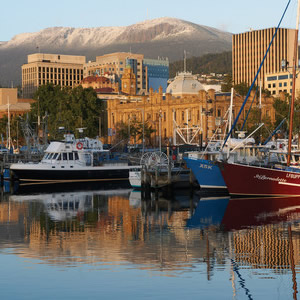State of Markets - TAS February 2015
The steadily moving Tasmanian market looks set to pick up over 2015

In the 12 months to December, property values in Hobart rose by 3.5 per cent, according to CoreLogic RP Data. This figure puts Hobart fifth in the state capital standings for annual growth.
However, the city placed first among the state capitals for growth over the month of December, with a rate of 2.7 per cent.
The research house reports that the median price for a dwelling in Hobart is now $341,500. This is the lowest median price of any state capital – and significantly lower than the next cheapest location, Adelaide, which recorded a median price of $410,000.
CoreLogic RP Data head of research Tim Lawless anticipates growth in Tasmania’s capital to be moderate in the coming months.
He points to downturns in the agricultural and tourism sectors as key factors in Hobart’s weaker property performance post-GFC compared to other capital cities. Hobart dwelling values remain 3.9 per cent lower than what they were at the start of 2009.
Mr Lawless explains that more recently, housing market conditions have started to improve across Hobart. A recent study from CoreLogic RP Data suggests that transaction numbers have recorded a sharp rise from a low base and dwellings show a remarkable level of affordability compared to other capital cities.
As demand from lifestyle buyers continues to rise, Mr Lawless expects Hobart home values to continue their moderate growth trend during 2015.
SQM head of research Louis Christopher also put Hobart in the spotlight in a recent interview, citing “movement” in the market. He says that historically, Hobart has been a weak economy, has experienced weak-to-negative population growth and subsequently, a weak housing market.
However, he says that the lower Australian dollar helps the Tasmanian economy on many levels.
With these factors in mind, Mr Christopher says that prices are well undervalued by historical standards and are in a prime position to move upwards in 2015.
In focus
Between the 1960s and 1980s, public housing was widespread in the greater-Hobart suburb of Claremont. However, most of these houses have now been sold off and bought predominantly by owner-occupiers.
Residents can shop at the Claremont Plaza, and choose from a range of restaurant options at this location.
The travel time to Hobart’s CBD is about 20 minutes.
Claremont has a TAFE campus, a senior secondary college, two government primary schools and one private primary school. It has sporting ovals and parks and is home to the famous Cadbury Chocolate Factory.
The market comprises a mixture of older weatherboard homes and new developments, many of which have great views of the Derwent River.
Although CoreLogic RP Data reports a median price for a two-bedroom unit as $215,000, I am aware of properties of this type being advertised for about $150,000, with rental returns of six per cent.
If an investor puts the time in, they will be able to find some great opportunities in Claremont. I recently found neat little weatherboard dual occupancy advertised for just over $200,000.
It’s currently rented for a total of $400 a week, and has the potential for a large block of land to be developed. This equates to a rental yield of over seven per cent together with an add-value opportunity, all for under $300,000.
Rental yields in the suburb are very competitive, even when compared to Hobart city. SQM Research will show you that the asking price for a three‑bedroom house in Hobart is $478,900, with a rent of $444 per week. This translates to a rental yield of 4.82 per cent, which is strong by any capital city standard.
To compare, SQM reports that the asking price for a three-bedroom home in Claremont is $261,900, with a rent of about $300 per week.
That’s a very healthy rental yield of 5.9 per cent. Investors who purchase a two-bedroom unit for just under $200,000 can expect a rental yield of 6.6 per cent.
I feel the outlook for the area moving into 2015 and beyond is very good. Properties in Hobart are currently somewhat undervalued and are due for an increase. Moreover, the area’s increase in rents over the past couple of years suggests that a growth spurt is on the horizon.
The key indicators for property price growth are population, infrastructure, demographics, economics, supply and demand, and yield variation. Although wider Tasmania has been troubled by economic issues in the past, I feel that the Claremont market is resilient.
Fast 5 hotspots